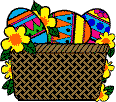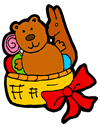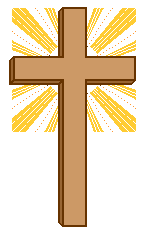



Family Network


|


Family Network


|
|
 Harvest Festivals Net 
All that is contained in the basket is of meaning such as the colored eggs mean the risen Christ, the bread and salt are for good health and a prosperous life, the sausages are supposed to be a wish for enough food and fertility for the coming spring. There is also cheese and marzipan which are another part of the Easter basket.
Another tradition is the tradition of Watering which is where everyone splashes each other with water as this is considered to bring good health to all. No one is safe from this tradition.
In Poland for over 800 years Easter Monday has been "Switching Day". On this day boys swat their girlfriends with a small willow branch. On Easter Tuesday the girls get even by swatting the boys.
In Poland a cake like bread is eaten. It is shaped like a peasant woman's full skirt.
In Poland it is the custom to decorate the eggs with rug yarn.
Dyngus or Smingus Dyngus is celebrated in Poland on the first Monday after Easter. On this day boys lie in wait to sprinkle girls with water or perfume. It is said that girls who get caught and soaked with water will marry within the year. This may be the very reason why some girls make feeble attempts to escape the dousing.
This custom of dousing may be of pagan origin since the pouring of water is an ancient spring symbol of cleansing and purification. Another theory is that this represents the renewal of the sacrament of baptism after Christ has risen. Also, according to legend, the Polish ruler, Prince Mieszko the First was baptized in 966 on Easter Monday.
The first recorded account of Dyngus dates back to the Middle Ages when the custom was known as Oblewania. Evidently, the women were given ample time to retaliate. The old chronicle says that "on Tuesday and every day thereafter until the time of the Green Holidays or Pentecost where the women doused the men.
In Poland, the food is set out ready all day long, so that everyone can eat just when they feel like it. The table is decorated with green leaves and a sugar lamb may be placed as a centre-piece.
At the feast there are cold meats and salads and plenty of eggs. Children take samples of food to church to be blessed by the priest.
In Poland the Kitchen table is covered with evergreen leaves and then Easter food is put on it. Before anything is eaten it must blessed first by the priest.

Mens.Net | Womens.Net | Mothers.Net | Fathers.Net | Grandparents.Net | Teenagers.Net | Santas.Net | EasterBunnys.Net | JackOLanterns.Net | FatherTimes.Net | StValentines.Net HarvestFestivals.Net | BirthdayCelebrations.Net | ToothFairys.Net
 Please read our Legal Statement and Privacy Policy.
|